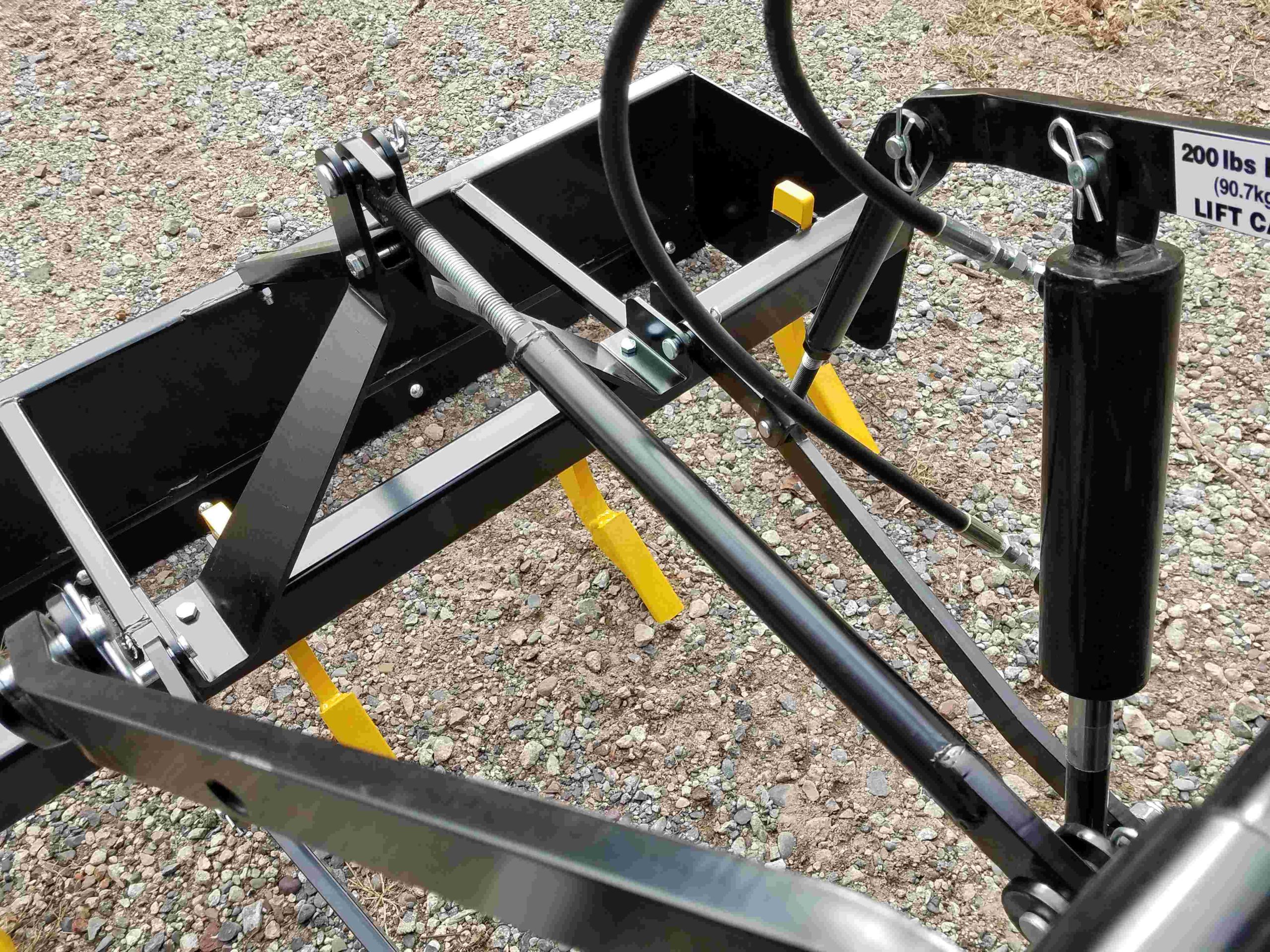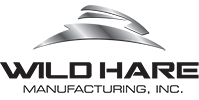Whether you are plowing a field, leveling or grading a road with a box blade, or preparing a field for seed, the 3 point hitch is the essential tool for farmers, landscapers and DIYers. It has many advantages over common single point ball hitches commonly found on cars and trucks. This article will detail how three-point hitches work, the advantages and disadvantages of them, the different categories of hitches, and what is required to maintain them and keep them in good operating condition.

What is a 3 Point Hitch?
The 3-point hitch is a device bolted to the back of an ATV or tractor, allowing the operator or farmer to quickly attach and detach cultivators, discs, box blades, and other implements. It also provides precision control side to side and accurate depth control, unlike most other hitches. Some 3-point hitches, such as the Wild Hare ATV Implement System, even offer the ability to provide positive down pressure. This means the hitch doesn’t rely solely on the weight of the implement to drive it into the ground but also utilizes hydraulics that incorporate the weight of the ATV and operator, making it far more effective than a gravity-style 3-point hitch. The hitch features arms extending from the back of the ATV that allow attachments or implements to easily connect.
Components of a 3 Point Hitch
The three main components of a 3 point hitch are the linkage arms, the lower link arms, and the center or top link. The lower link arms are the strong foundation of the hitch, responsible for handling most of the weight and keeping things stable. The linkage arms, on the other hand, help control the movement of the implement, allowing it to be lifted or lowered. And finally, the center (top) link, which is adjustable in length, helps maintain the implement’s position relative to the tractor. Some hitches also have threaded side adjustment links that attach the linkage arms to the lower link arms on each side. This makes it easy for the operator to tilt the implement right to left or to make it flat or parallel with the ground, depending upon the task.
How Does a 3 Point Hitch Work?
Now that we know the players, let’s understand how they work together to get the job done. The beauty of a 3 point hitch lies in its versatility and convenience.
When you’re ready to attach an implement, simply back the 3 point hitch up to the implement, align the lower link arms to the locations on the implement and pin them together. The top link is then adjusted by screwing it in or out to achieve the desired working height, stability and tilt of the implement, and then pinned a similar way. It is that easy.
Working Mechanism of 3 Point Hitches
But here’s where the magic happens. The 3 point hitch leverages the power of hydraulics. With a flick of a switch or the turn of a knob, the hydraulic system comes to life, allowing you to raise or lower the implement effortlessly from the operator’s seat. This means you can easily adjust the depth of plowing, tilling, or any other task you may be tackling. It also allows such things as grading or plowing close to a fence or wall by backing up to the structure, lowering the attachment and pulling forward thus plowing or grading very close to most any immovable object.
But wait, there’s more! The movement of the implement doesn’t stop there. Thanks to the linkage arms, you can control the lateral movement, allowing for additional precise maneuvers. Do you want to put a crown or a raised middle on your gravel driveway to let the water flow off better? No problem. Adjust the threaded linkages on the left and right side and you are off and running. And let’s not forget that the 3-point hitch’s design ensures an even distribution of weight, providing stability and reducing the strain on both the tractor and the operator.
Advantages of 3 Point Hitches
Increased Stability and Control
One of the major advantages of three-point hitches is the stability and control they provide. They help distribute the weight evenly between the tractor and the implement, and even side to side since the left and right hitch arms are mechanically welded together, giving you a nice and balanced setup. Think about how a trailer hitched to a truck just floats over the top of a road. It works great for simply towing but that style hitch wouldn’t work nearly as well for pushing a plow into soil. Additionally, sometimes you want to control the depth that you are pushing the implement into the ground, such as trying to regain traction. A hydraulically controlled three-point hitch allows you to do that too!
Versatility and Compatibility
Here’s where things get even more exciting. Three-point hitches are very adaptive. They can be adjusted to fit different implements, meaning you can switch between tasks without breaking a sweat. Whether you need to plow, disc, level, or dig – a 3 point hitch will have your back, no matter what.
Ease of Attachment and Detachment
Let’s face it, nobody likes fiddling around when it comes to hooking up equipment. Well, guess what? Three-point hitches are all about efficiency. They make attaching and detaching implements a breeze, saving you precious time and frustration. Just think of what you can do with all the time you save!
Disadvantages of 3 Point Hitches
Limited Weight Capacity
Okay, it’s not all sunshine and rainbows in the world of three-point hitches. One downside is their limited weight capacity. You can’t overload them with extremely heavy equipment unless you want to risk some serious damage. So, if you’re planning on taking on Herculean tasks, you might need to consider alternative hitch options.
Are There Different Sizes of 3 Point Hitches?
All three-point hitches are not the same. Just as there are different size ATVs and tractors, there are different size hitches that attach to them. After all you wouldn’t want to put a 40-foot plow on the back of an ATV or small lawn or garden tractor. Within each Category of 3-Point Hitches, the attachment points, attachment locations and diameters of pins are universal. So, for example, all standard Category 0 three-point hitches will accept and fit all standard Category 0 implements but will only accept category 0 implements.
| Category | HP | Center (Top) link pin diameter |
Linkage arm pin diameter | Lower Link Arms spacing |
| 0 | Up to 20 hp | 5⁄8 in | 5⁄8 in | 20 in |
| 1 | 20 to 45 hp | 3⁄4 in | 7⁄8 in | 28 in |
| 2 | 40 to 100 hp | 1 in | 1 1⁄8 in | 34 in |
| 3 | 80 to 225 hp | 1 1⁄4 in | 1 7⁄16 in | 40 in |
| 4 | More than 225hp | 1 3⁄4 in | 2 in | 48 in |
Maintenance and Care of 3 Point Hitches
Regular Inspection and Cleaning
Just like any other mechanical system, 3 point hitches require some TLC to keep them in tip-top shape. Regular inspections are key to preventing potential issues. Take a good look at the linkage arms, lower link arms, and center (top) link for signs of wear or damage. Tighten any loose bolts and replace worn-out parts before they give you a surprise in the field. Also check hydraulic hoses and fittings for any wear and replace if necessary.
And let’s not forget about cleanliness! Make sure to remove any dirt, debris, or grass that may have accumulated on the hitch. A clean 3-point hitch not only functions better but also looks good and lasts longer.
Lubrication and Greasing
Lubrication is the key to keeping 3 point hitch running smoothly. It is always a good idea to keep joints, pivot points and bushings well lubricated to extend the life of your 3-point hitch. It may not be the most glamorous task, but a well-lubricated hitch will save you headaches down the road.
3 Point Hitches Summary
3-point hitches offer numerous advantages in terms of stability, versatility, and ease of use. They provide DIYers, farmers, and landscapers with the ability to efficiently connect and control a wide range of implements, making them an indispensable tool in the agricultural industry and around your home. By properly selecting, maintaining, and caring for these hitch systems, users can ensure their longevity and reliable performance. Ultimately, understanding the workings and considerations of 3 point hitches empowers individuals to make informed decisions and optimize their free time!
3 Point Hitch FAQs
Are 3 point hitches compatible with all types of ATVs/tractors?
Yes, 3-point hitches are designed to be compatible with most standard ATVs and tractors. However, it is essential to ensure that the hitch category and size are suitable for your specific tractor model.
Can I attach various implements to a 3 point hitch?
Yes, one of the significant advantages of 3 point hitches is their versatility. They allow you to attach a wide range of implements, including plows, disc harrows, rotary tillers, mowers, and more. Just ensure that the implement is designed to be used with the appropriate hitch category.
How do I maintain and care for a 3 point hitch?
Proper maintenance is crucial to ensure the longevity and optimal performance of a 3 point hitch. Regularly inspect the hitch for any damage or wear, clean it thoroughly, and lubricate the moving parts as recommended by the manufacturer. Additionally, always follow the maintenance guidelines provided by the tractor and implement manufacturers.
Can a 3 point hitch handle heavy loads?
While 3 point hitches are generally durable and robust, they do have weight capacity limitations. It is important to check the maximum weight capacity specified by the manufacturer and avoid exceeding it to prevent damage to the hitch or tractor. The size of the ATV or tractor is directly related to how much weight it can carry. Refer to your manufacturer’s manual for recommendations for safe operation.
Can you put 3 point hitches on a lawn tractor?
Some manufacturers provide 3-point hitches as an accessory for their garden tractors. Additionally, some manufacturers also provide aftermarket 3-point hitches that will also fit on ATVs or quads allowing cultivators, discs and box blades to be operated.

 100% Designed & Manufactured in the USA, with some foreign parts.
100% Designed & Manufactured in the USA, with some foreign parts.














